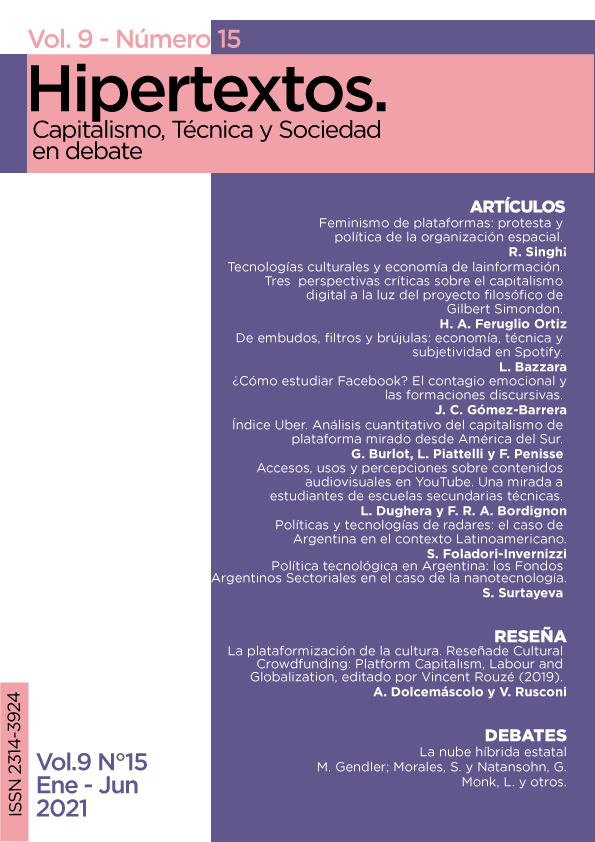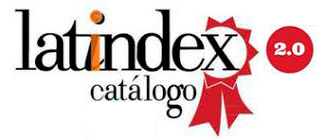Radar policies and technologies: The case of Argentina in the Latin American context
DOI:
https://doi.org/10.24215/23143924e032Keywords:
dual technology, radar technology, radarization policies, scientific technological dependenceAbstract
The development of radars dates back to a few years before World War II, and its name derives from an acronym: Radio Detection and Ranging. In this work, taking the case of radar technology in Argentina, we present some challenges to achieve technological autonomy in peripheral countries. In Argentina, the production of national radars occurred much later than in industrialized countries. Until the early 2000s, the radarization policies in Argentina were not effective, and many of the plans that started were discontinued. However, even late in the international context, Argentina stands out as pioneer on radar technology in the Latin American context. Examining the case of radars in Argentina, we can discuss some crucial issues in the area of science and technology, such as technology transfer, scientific dependence and dual technology. Given the dual characteristic of radars, geopolitical issues and historical moments constitute a central point in their development. From the analysis carried out, we can conclude the importance and prominent role of Argentina in the Latin American context with respect to radar technology. In a few years they passed from having a small portion of the national territory covered by radars to covering practically the entire national area, a change that occurred only after the beginning of national production of radars. The importance of technological autonomy in Argentina and the central role played by the INVAP Company are also highlighted. Finally, it is necessary to reflect on the need for continuous and systematic support from the state to allow for technological autonomy in cases such as the one analyzed in this paper. In high-tech areas, the achievements of peripheral countries are threatened by the accelerated dynamics of innovation led by central countries.
Downloads
References
Abila, F., Martins, J. & Cepik, M. (2009). Armas estratégicas e poder no sistema internacional: O advento das armas de energia direta e seu impacto potencial sobre a guerra e a distribuição multipolar de capacidades. Contexto Internacional, 31(1), 49–83.
Aita, E., Studart, Á. V., & Oliveira, M. A. G. (2016). Current overview and future perspectives on integrated defense logistics in South America: Opportunities for the regional defence industry. Austral: Brazilian Journal of Strategy & International Relations, 5(10), 199–228.
Alic, J. A. (1994). The dual use of technology: Concepts and policies. Technology in Society, 16(2), 155–172.
Alonso, M. (2018). Radar en la tormenta [Universidad Nacional de San Martín]. Agencia TSS. unsam.edu.ar/tss/radar-en-la-tormenta/
Brandt, L. (1994). Defense Conversion and dual-use technology: The push toward civil-military integration. Policy Studies Journal, 22(2), 359–370.
Caillaud, F., & Méniere, Y. (2014). Strategic intelligence on patents. En Patent markets in the global knowledge economy: Theory, empirics and public policy implications. Madiès, T., Guellec, D., & Prager, J.-C.
Cowan, R., & Foray, D. (1995). Quandaries in the economics of dual technologies and spillovers form military to civilian research and development (Núm. 9509). Department of Economics, University of Western Ontario.
Defence-aerospace. (2002). Lockheed Martin selected to provide radar system for AT-63 Pampa trainer light attack aircraft. Defence-aerospace. http://www.defense-aerospace.com/articles-view/release/3/9449/lockheed-radar-for-at_63-pampa-(apr.-3).html
Diamand, M. (1976). Las posibilidades de una técnica nacional en Latinoamérica (el caso argentino). Estudios Internacionales, 9(34), 10–41.
González, O. F. (2017). Caracteísticas de los distintos tipos de radares. Gaceta Aeronautica. https://www.gacetaeronautica.com/gaceta/wp-101/?p=22789
Guevara, I. (2020). El dios murciélago: Tecnología y radares mexicanos. El Heraldo de México. https://heraldodemexico.com.mx/opinion/2020/6/23/el-dios-murcielago-tecnologia-radares-mexicanos-186672.html
Hurtado, D., Lugones, M., & Surtayeva, S. (2017). Tecnologías de propósito general y políticas tecnológicas en la semiperiferia: El caso de la nanotecnología en la Argentina. Revista Iberoamericana de Ciencia, Tecnología y Sociedad, 12(34). http://www.revistacts.net/volumen-12-numero-34
INVAP. (2020). INVAP - La empresa. INVAP. https://www.invap.com.ar/la-empresa/
Junior, O. F., Hurtado, D. Moreira, I. C., & Barros, F. de S. (2013). Nuclear wepons in regional contexts: The cases of Argentina and Brazil. An open world: science, technology and society in the light of Niels Bohr’s thoughts, Copenhagen.
López, A., Pascuini, P., & Ramos, A. (2018). Climbing the Space Technology Ladder in the South: The Case of Argentina. Space Policy, 46, 53–63. https://doi.org/10.1016/j.spacepol.2018.06.001
Lorenzo, C. (2002). Lockheed Martin renegotiates terms at Argentina facility. Defense Daily - Dow Jones Factiva, 216(3).
Madies, T., Guellec, D., & Prager, J.-C. (Eds.). (2014). Patent Markets in the Global Knowledge Economy: Theory, Empirics and Public Policy Implications. Cambridge University Press. https://doi.org/10.1017/CBO9781107110960
Markets&Markets. (2020). Aircraft Sensors Market by Connectivity, Platform, Sensor, Application, End Use COVID-19 Impact Analysis. Aircraft Sensors Market. https://www.marketsandmarkets.com/Market-Reports/aircraft-sensors-market-53630527.html
Mayer, F., & Gereffi, G. (2010). Regulation and Economic Globalization: Prospects and Limits of Private Governance. Business and Politics, 12(3). https://doi.org/10.2202/1469-3569.1325
Mazzucato, M. (2017). El Estado emprendedor: Mitos del sector público frente al privado. RBA.
Medellín, J. A. (2020). La marina y el ejército mexicanos concluyen su primer radar de vigilancia aérea. defensa.com. https://www.defensa.com/mexico/marina-ejercito-mexicanos-concluyen-primer-radar-vigilancia
Medina, J. (2020, noviembre 29). Entre lo urgente y lo importante: Radares. Aviación21. https://a21.com.mx/index.php/inteligencia-aeroespacial/2020/09/13/entre-lo-urgente-y-lo-importante-radares
Omnisys. (2017, junio 22). A Thales apresenta o LP23SST NG, o radar de vigilância em rota de uso dual civil e militar mais avançado do mundo e já vendido para o Brasil. Omnisys. https://www.omnisys.com.br/a-thales-apresenta-o-lp23sst-ng-o-radar-de-vigilancia-em-rota-de-uso-dual-civil-e-militar-mais-avancado-do-mundo-e-ja-vendido-para-o-brasil
OMPI. (2010). Indicadores mundiales de propiedad intelectual. Organización Mundial de la Propiedad Intelectual. http://www.wipo.int/edocs/pubdocs/es/intproperty/941/wipo_pub_941_2010.pdf
Piñeiro, L. (2015). Argentina inagura el tercer radar primario 3D de largo alcance y firma contrato para la construcción de seis nuevos radares. defensa.com. https://www.defensa.com/argentina/argentina-inaugura-tercer-radar-primario-3d-largo-alcance-firma
Potenze, P. L. (2017). Los radares argentinos. Gaceta Aeronautica. https://www.gacetaeronautica.com/gaceta/wp-101/?p=22386
Prime Faraday. (2002). An Introduction to MEMS (Micro-electromechanical Systems)—An-introduction-to-mems.pdf. Prime Faraday Technology Watch. http://www.lboro.ac.uk/microsites/mechman/research/ipm-ktn/pdf/Technology_review/an-introduction-to-mems.pdf
Quiroga, J. M. (2018). Políticas públicas, trayectorias institucionales y desarrollo tecnológico nacional. Los primeros sesenta años de tecnología radar en la Argentina. En Políticas de ciencia, tecnología e innovación en la Argentina de la postdictadura. Editorial UNRN.
Quiroga, J. M. (2020). Capacidades dinámicas en la producción de bienes intensivos en conocimientos. El caso del desarrollo de radares en Argentina (2003-2015). CTS - Revista Iberoamericana de Ciencia, Tecnología y Sociedad. https://doi.org/10.13140/RG.2.2.27266.63680
Quiroga, J. M., & Aguiar, D. (2016). Abriendo la “caja negra” del radar. Las políticas de radarización para uso civil y de defensa en Argentina entre 1948 y 2004. H-Industri@: Revista De Historia De La Industria, Los Servicios Y Las Empresas En América Latina, 19, 71–100.
Sábato, J. A. (2004). Ensayos en campera (1a ed.). Bernal: Univ. Nacional de Quilmes Editorial.
Susskind, C. (1994). Radar as a case study in simultaneous invention. En Tracking the history of radar. IEEE-Rutgers Center for the History of Electrical Engineering and the Deutsches Museum.
Toledo, D. G. C. (2019). Aspectos históricos e conceituais da dependência tecnológica da América Latina sob o novo neocolonialismo. OIKOS, 18(3), 41–56.
Vasconcelos, Y. (2013). De misiles a radares. Pesquisa Fapesp, 202. https://revistapesquisa.fapesp.br/es/de-misiles-radares/
Vassallo, C. M. (2008). Control del espácio aéreo en la República Argentina [Ministerio de Justicia y Derechos Humanos Argentina]. SAIJ. http://www.saij.gob.ar/doctrina/dacf080092-vassallo-control_espacio_aereo_en.htm%3Bjsessionid=el1a0negeh3fppq327uq3y5e?0
























